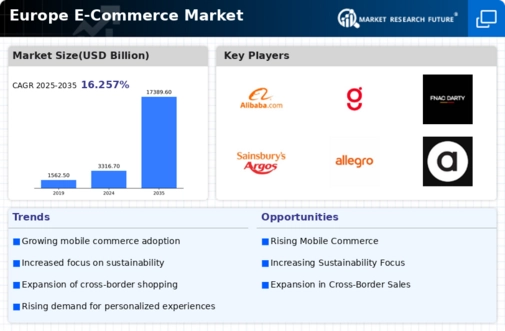The Europe E-Commerce Market has evolved into a dynamic and competitive landscape characterized by a rapid increase in online shopping and diverse consumer preferences. As digital transformation continues to shape retail, countless players vie for market share, leveraging technology to enhance customer experience and streamline operations. The rising sophistication of consumer expectations has compelled companies to innovate continuously, resulting in a robust ecosystem that fosters competition among both established leaders and emerging platforms.
This competitive insight highlights strategic initiatives, market presence, and factors that contribute to the success of players within the European e-commerce domain, alongside the shifting trends that impact their positioning. Amazon has established itself as a formidable force in the European E-Commerce Market, capitalizing on its vast product range, superior logistics network, and customer-centric approach. One of the strengths of Amazon in Europe is its ability to offer an extensive selection of products, from electronics to groceries, catering to various consumer needs. Furthermore, Amazon Prime offers attractive memberships that enhance customer loyalty through fast shipping and access to exclusive services.
Its advanced technology, including data analytics and AI-driven recommendations, delivers personalized shopping experiences that resonate with European consumers. Additionally, Amazon's investment in local fulfillment centers within Europe has significantly improved delivery times, further cementing its reputation as a reliable online retailer. As the market continues to grow, Amazon's strategic initiatives will further deepen its foothold in the European e-commerce landscape. Alibaba, while traditionally known for its dominance in the Asian marketplace, has also made inroads into the European E-Commerce Market, aiming to foster connections between consumers and businesses.
Alibaba's strengths include its robust platform that facilitates business-to-business and consumer-to-consumer transactions, allowing for a wide range of products to be traded efficiently. Key services such as Alipay enhance transactional capabilities, providing secure payment solutions that appeal to European users. The company has pursued strategic partnerships and collaborations to enhance its market presence in Europe, focusing on local marketing strategies and logistics partnerships that improve supply chain efficiency. Alibaba's focus on bridging international trade and providing access to Chinese products through its e-commerce platforms presents a unique value proposition for European consumers.
Mergers and acquisitions have further bolstered their position within Europe, allowing the company to leverage local expertise and integrate into existing marketplaces effectively. With its continuous efforts tailored toward the European market, Alibaba positions itself as a growing player in the region's e-commerce ecosystem.






















Leave a Comment